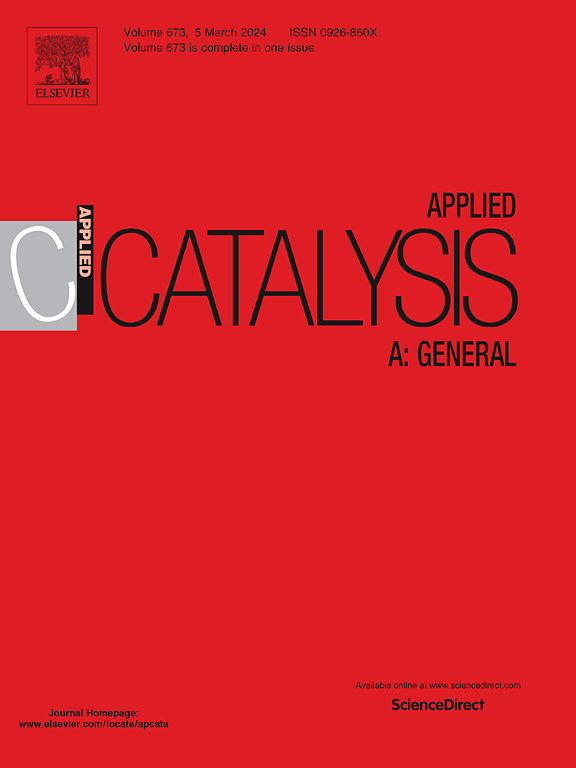利用钒和H2O2作为绿色氧化剂进行有机分子功能化
IF 4.8
2区 化学
Q2 CHEMISTRY, PHYSICAL
引用次数: 0
摘要
钒催化剂与过氧化氢(H₂O₂)作为绿色氧化剂配对,为有机分子的选择性氧化功能化提供了一个多功能和可持续的平台。本文综述了钒-氢氧催化在主要转化中的最新进展,即环氧化,CC键的氧化裂解,醇的氧化,C-H键的活化,硫化物氧化,卤化和串联氧化过程。重点放在配体设计,特别是希夫碱配体和多金属氧酸盐如何调节催化活性,选择性和稳定性。讨论了活性钒的作用,如单钒酸盐和过钒酸盐,以及机理,构效关系,以及溶剂和氧化剂控制的影响。可持续性使用绿色化学指标进行评估,包括原子经济性,e因子,过程质量强度(PMI),周转率(TON)和周转率(TOF)。尽管取得了显著的进展,但诸如催化剂失活、非活化C-H氧化的有限功效以及机制解决不足等挑战仍然存在。本文总结了配体设计和反应器工程方面的新兴策略,将钒- h2o系统定位为可扩展、高效和可持续氧化化学的有前途的平台。本文章由计算机程序翻译,如有差异,请以英文原文为准。
Leveraging vanadium and H2O2 as green oxidant in functionalisation of organic molecules
Vanadium catalysts paired with hydrogen peroxide (H₂O₂) as a green oxidant offer a versatile and sustainable platform for the selective oxidative functionalization of organic molecules. This review provides a comprehensive survey of recent advances in vanadium–H₂O₂ catalysis across essential transformations, namely epoxidation, oxidative cleavage of C![]() C bonds, oxidation of alcohol, C–H bond activation, sulfide oxidation, halogenation, and tandem oxidative processes. Emphasis is placed on how ligand design particularly Schiff base ligands and polyoxometalates tunes catalytic activity, selectivity, and stability. The role of reactive vanadium species, such as mono- and peroxovanadates along with mechanistic insights, structure–activity relationships, and the influence of solvent and oxidant control are discussed. Sustainability is evaluated using green chemistry metrics including atom economy, E-factor, process mass intensity (PMI), turnover number (TON), and turnover frequency (TOF). Despite notable progress, challenges such as catalyst deactivation, limited efficacy in unactivated C–H oxidations, and insufficient mechanistic resolution persist. This review concludes by highlighting emerging strategies in ligand design and reactor engineering, positioning vanadium–H₂O₂ systems as promising platforms for scalable, efficient, and sustainable oxidation chemistry.
C bonds, oxidation of alcohol, C–H bond activation, sulfide oxidation, halogenation, and tandem oxidative processes. Emphasis is placed on how ligand design particularly Schiff base ligands and polyoxometalates tunes catalytic activity, selectivity, and stability. The role of reactive vanadium species, such as mono- and peroxovanadates along with mechanistic insights, structure–activity relationships, and the influence of solvent and oxidant control are discussed. Sustainability is evaluated using green chemistry metrics including atom economy, E-factor, process mass intensity (PMI), turnover number (TON), and turnover frequency (TOF). Despite notable progress, challenges such as catalyst deactivation, limited efficacy in unactivated C–H oxidations, and insufficient mechanistic resolution persist. This review concludes by highlighting emerging strategies in ligand design and reactor engineering, positioning vanadium–H₂O₂ systems as promising platforms for scalable, efficient, and sustainable oxidation chemistry.
求助全文
通过发布文献求助,成功后即可免费获取论文全文。
去求助
来源期刊

Applied Catalysis A: General
化学-环境科学
CiteScore
9.00
自引率
5.50%
发文量
415
审稿时长
24 days
期刊介绍:
Applied Catalysis A: General publishes original papers on all aspects of catalysis of basic and practical interest to chemical scientists in both industrial and academic fields, with an emphasis onnew understanding of catalysts and catalytic reactions, new catalytic materials, new techniques, and new processes, especially those that have potential practical implications.
Papers that report results of a thorough study or optimization of systems or processes that are well understood, widely studied, or minor variations of known ones are discouraged. Authors should include statements in a separate section "Justification for Publication" of how the manuscript fits the scope of the journal in the cover letter to the editors. Submissions without such justification will be rejected without review.
 求助内容:
求助内容: 应助结果提醒方式:
应助结果提醒方式:


